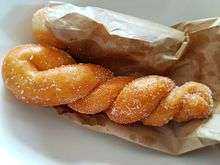Twisted doughnut
Twisted doughnuts are yeast donuts or sticks of pastry made from braided wheat or glutinous rice flour, deep-fried in oil.[1] In Korea, they are known as kkwabaegi (꽈배기),[2] and in the Philippines, as shakoy and pilipit.[3]
 Filipino shakoy | |
| Type | Doughnut |
|---|---|
| Course | Snack |
| Place of origin | Korea, Philippines |
| Associated national cuisine | Korean cuisine, Filipino cuisine |
Around the world
Korea
| Korean name | |
| Hangul | 꽈배기 |
|---|---|
| Revised Romanization | kkwabaegi |
| McCune–Reischauer | kkwabaegi |
| IPA | [k͈wa.bɛ.ɡi] |
Twisted doughnuts are known as kkwabaegi (꽈배기) in Korean. The mildly sweet, fluffy, spongy, twisted doughnuts are made with yeasted wheat or glutinous rice flour dough and melted butter. They are deep-fried in oil and coated with sugar and cinnamon powder.[1][2][4] It is often an after-school snack.[4]
Philippines
Shakoy or siyakoy from the Visayas Islands (also known as lubid-lubid in the northern Philippines) uses a length of dough twisted into a distinctive rope-like shape before being fried. The preparation is almost exactly the same as doughnuts, though there are variants made from glutinous rice flour. The texture can range from soft and fluffy to sticky and chewy. Hard and crunchy versions are known as pilipit. They are sprinkled with white sugar, but can also be topped with sesame seeds or caramelized sugar.[5][6][7]
Vietnam
In Vietnam, it has a variety of name such as Bánh Quẩy Thừng[8], bánh vặn thừng (twisted-rope doughnut), bánh vặn (twisted doughnut), bánh quai chèo (oar rope doughnut), bánh quẩy đường (sweet twisted doughnut).
China & Taiwan
In Mainland China and Taiwan, Twisted doughnut known as mahua (麻花) is a snack with crunchy texture.
Italy
In Italy it is known as treccia, sometimes filled with pastry cream and covered with sugar, chocolate and other products.
References
- "Kkwabaegi" 꽈배기. Korean-English Learners' Dictionary. National Institute of Korean Language. Retrieved 19 August 2017.
- Kaiserman, Beth (24 September 2016). "A Brief History of the Doughnut". Highbrow. Retrieved 19 August 2017.
- "Flavor fanatics open Coffee Break Cafe". Corvallis Gazette Times. 1970-01-01. Retrieved 2017-08-20.
- Shah, Khushbu (30 December 2015). "Pastries Born in France, Raised in South Korea". Eater. Retrieved 19 August 2017.
- "How to cook Shakoy". Pinoy Recipes. Retrieved 3 January 2015.
- "Shakoy or Lubid-Lubid Recipe". Ping Desserts. Retrieved 3 January 2015.
- "Pilipit". Kawaling Pinoy Tasty Recipes. Retrieved 26 March 2019.
- VCCorp.vn (2016-11-16). "Làm quẩy thừng thơm giòn đúng chất Hà Nội để dành nhâm nhi ngày lạnh". aFamily (in Vietnamese). Retrieved 2019-08-11.
Further reading
- Moore, F. (1866). Anecdotes, Poetry, and Incidents of the War: North and South. 1860-1865. Frank Moore. p. 73. Retrieved August 20, 2017.
